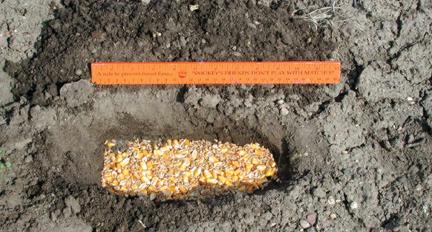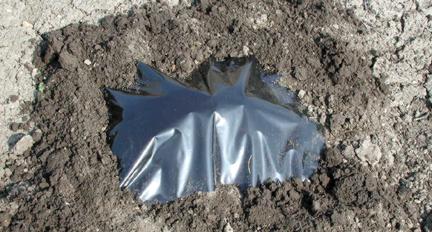Trap wireworms before planting corn
|
Wireworms can damage corn, resulting in stand loss during the seedling stage. Wireworms are the immature stage of click beetles and they range in length from 1/4 to 1 1/2 inches. Wireworms are found most often in grasslands or fields recently planted in sod. Occasionally, they are found in fields without any recent history of grasses. Why wireworms occur in damaging numbers in fields without grasses is a mystery. A few years ago, Steve Lefko, a graduate student in entomology at Iowa State University, did intensive surveys of wireworms in Iowa. His research indicated that wireworms could be found in 45 percent of grassland fields (such as Conservation Reserve Program), and he determined that wireworms are more likely to occupy well-drained soils commonly found on ridgetops or hillsides. Wireworms can spend several years in the immature stage during which they feed on newly planted corn seeds as well as roots of established corn. There is no evidence that wireworms reduce yield in soybean. Unfortunately, wireworm damage is usually detected after corn has been planted and the opportunity for making preventive pest management choices has passed. This situation makes wireworm scouting before planting a wise decision. Scouting for wireworms is most easily accomplished with a bait trap. The trap should be in the soil at least 1 week before planting. Wireworms are more likely to be near the soil surface as the soil temperature increases in the spring, so scouting close to planting will increase the likelihood of finding wireworms. Building a wireworm trap is a simple 7-step procedure (see numbers 1-5 on photos, corresponding to steps 1-5 below).
Research has shown that four traps per acre are ideal, but this trap density is probably unrealistic for most situations. A minimum of 10 traps should be used in any field, although this number may compromise accuracy in large fields. The bait should be collected and examined after 1 week in the soil. The total number of wireworms per bait should be counted and an average number calculated. Several integrated pest management options are possible if wireworms are detected, including crop rotation, insecticides, and altered planting dates. If more than one wireworm per trap is found, there is a high probability of damage to corn seeds and seedlings. Use a granular soil insecticide at planting with corn, placing the insecticide in the furrow, or rotate to a nonhost crop such as soybean. If less than one wireworm per trap is found, the probability of wireworm damage is low but still possible. A seed treatment should be used to protect corn seed in this situation, but seed treatments protect only the seed and will not protect the seedling. If no wireworms are found, the probability of wireworm damage is very low, but still possible; wireworms may be present but at very low densities and not detected in the bait traps. For seed treatments to be effective, all seeds must be coated with the chemical. Incomplete seed coverage can result in inadequate seed protection. Delayed planting is another method to reduce wireworm damage. If wireworms were detected in the baits or the cornfield has a history of wireworm problems, delayed planted should be considered. Early-planted corn is more likely to germinate slowly because of cool and wet soil conditions; these slow-growing plants are susceptible to wireworm damage. In contrast, planting later, usually during warmer soil conditions, allows faster seed germination and seedling growth. This rapid plant growth helps avoid serious damage caused by wireworms. This article originally appeared on pages 44-45 of the IC-490 (5) -- April 21, 2003 issue. Updated 04/20/2003 - 1:00pm
|







